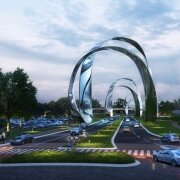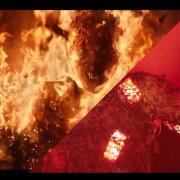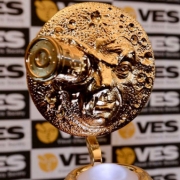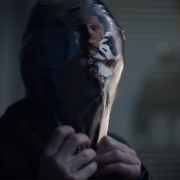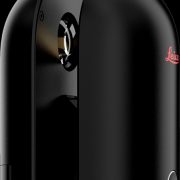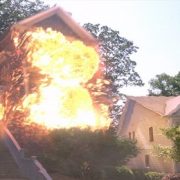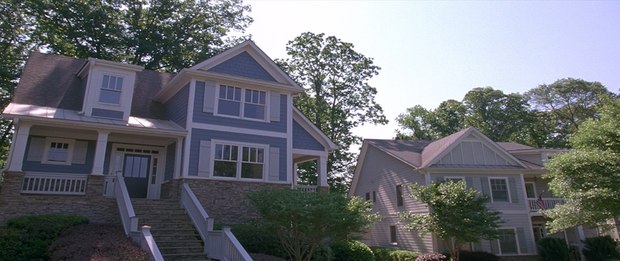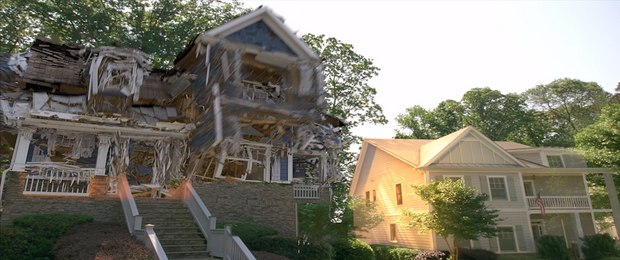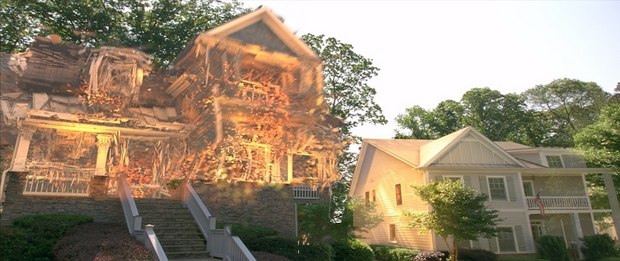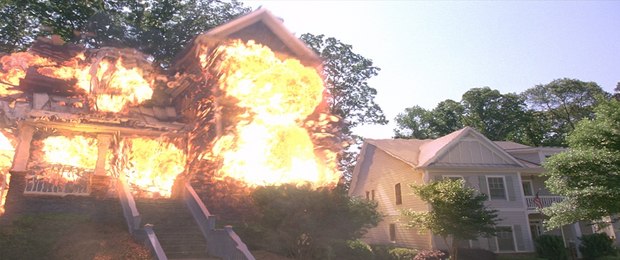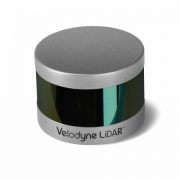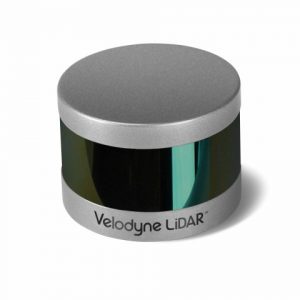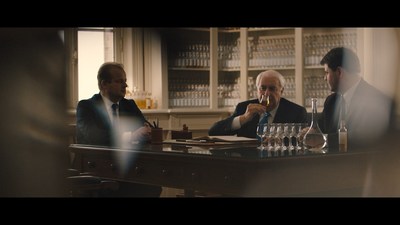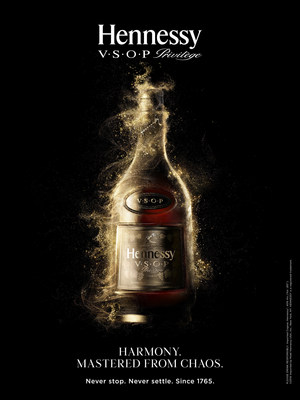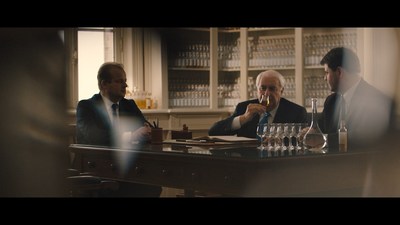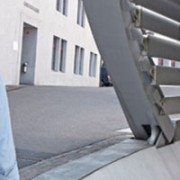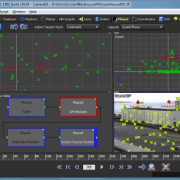Fire, Prosthetics, LED’s and VFX: ‘Project Power’
/0 Comments/in Blog, Featured, In the News, LiDAR, Photogrammetry, Point Cloud, Visual Effects (VFX)/by Ty TaylorVES Awards: ‘The Lion King’ & ‘The Irishman’ Take Top Film Honors
/0 Comments/in 3D Laser Scanning, Blog, LiDAR, Visual Effects (VFX)/by Ty TaylorVES Awards: ‘The Lion King’ & ‘The Irishman’ Take Top Film Honors
By Erik Pedersen, Antonia Blyth
January 29, 2020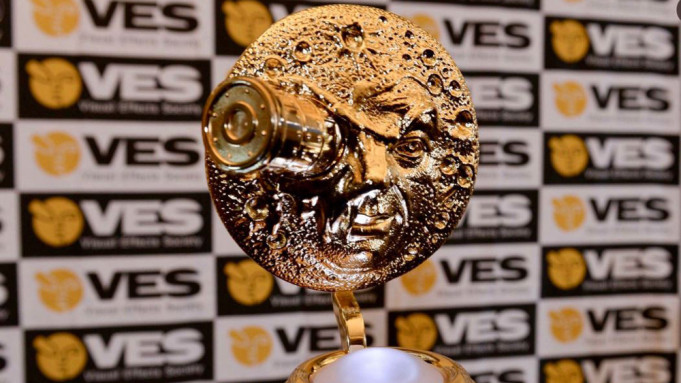
Summary
VES Awards: ‘The Lion King’ & ‘The Irishman’ Take Top Film Honors
Disney’s The Lion King ruled the 18th annual VES Awards, winning a pack-leading three trophies including the marquee Outstanding Visual Effects in a Photoreal Feature during Wednesday night’s ceremony at the Beverly Hilton.
The Jon Favreau-directed “live action” remake of the toon classic also took the hardware for Outstanding Created Environment in a Photoreal Feature and Virtual Cinematography in a CG Project, setting it up as a front-runner for the Best Visual Effects Academy Award on February 9. More on that below.
Accepting the top prize for The Lion King, visual effects supervisor Robert Legato said: “I do feel a little guilty because the fellow nominees were so great … but I’m pretty sure I’m going to get over it. … About 1,600 of our closest personal friends were involved.”
Netflix’s The Irishman and Laika’s Missing Link were the only other multiple winners on the film side. The time-jumping, de-aging film by Martin Scorsese, who received the VES Lifetime Achievement Award tonight, took Outstanding Supporting Visual Effects in a Photoreal Feature and a compositing award. The stop-motion Missing Link won for Visual Effects in an Animated Feature and Animated Character in an Animated Feature.
Also picking up a pair of trophies tonight were Disney+’s rookie series The Mandalorian, HBO’s recently wrapped Game of Thrones, Netflix’s creepshow Stranger Things 3 and the Ridley Scott-helmed commercial “Hennessy: The Seven Worlds.”
The Star Wars universe was well represented Wednesday night. Along with the dual Mandalorian wins, The Last Skywalker took Effects Simulations in a Photoreal Feature and Star Wars: Rise of the Resistance scored Visual Effects in a Special Venue Project.
Back to The Lion King and its Oscar chances. Since the VES Awards launched in 2002, the winner of its top film category has gone on to score the Best Visual Effects Oscar in 10 of the 17 years. (Hugo won the VES in the Feature Motion Picture category in 2011 and later won the Oscar.) But don’t shine up that mantel just yet: The Visual Effects Society and the Movie Academy have differed in each of the past two years, with 2017 VES winner War for the Planet of the Apes losing the Oscar to Blade Runner 2049 in 2017 and Avengers: Infinity War getting Thanos-ed by First Man at last year’s Academy Awards.
The Lion King and The Irishman will vie for the Visual Effects Oscar on February 9 against VES Awards nominees Avengers: Endgame, Star Wars: The Rise of Skywalker and 1917.
Host Patton Oswalt kicked off the ceremony with a few zingers: “Good evening. Disney permalancers!” he said. He later picked a Cats fight, noting: “The Star Wars franchise ended after 50 years, and after one screening, so did the Cats franchise. Isn’t that amazing? Were you guys on strike when they made that one? What was going on there? That movie was a screensaver designed to not give me a boner.”
J.J. Abrams later got a big laugh with this line, after Rian Johnson has presented earlier: “I’m here tonight to present three awards — unless Rian Johnson wants to come back and present the second one.”
Scorsese was unable to attend the ceremony but accepted his Lifetime Achievement Award via video. “I’m really very sorry that I can’t be there in person,” he said. “Thank you for this honor, which is very special to me because my pictures — they’re just not known for their visual effects. … I’m sort of a latecomer. I think I did my first visual effects from a wheelchair.”
The Oscar winner added: “Out of silence came the idea of the de-aging to utilize in the making of The Irishman. We all realized the risk we were taking, and we knew it was the only way we could make the picture we wanted to make.”
Roland Emmerich, who VFX-heavy films include Stargate, Independence Day, The Day After Tomorrow, 2012 and last year’s Midway, picked up the VES Visionary Award on Wednesday.
“People ask me a lot, ‘Why do you make all these huge visual effects movies?’ and I have to say the stories that fascinate me most are stories where people face extraordinary obstacles,” he said onstage. “I really enjoy to put a character in crazy possible danger and then watch them overcome these insurmountable obstacles. … Working in this business for 40 years, I know that if you want to get great visual effects, you need a lot of people — sometimes hundreds, sometimes thousands.”
Visual effects supervisor Sheena Duggal, whose dozens of credits range from Jumanji and Contact to Iron Man 3 and Venom, accepted the VES Award for Creative Excellence. “One of the things I love about my job is in this industry we truly succeed if we succeed together,” she said.
To see the list of VES Awards 2020 Winners click here.
Into the Looking Glass Mask with Marz
/0 Comments/in 3D Laser Scanning, LiDAR, Visual Effects (VFX)/by Ty TaylorLeica Geosystems and Autodesk Announce BLK360 $16k 3D Laser Scanner
/0 Comments/in 3D Laser Scanning, LiDAR, New Hardware, New Technology, News, Point Cloud/by Travis ReinkeLeica Geosystems Announces Complete Imaging Solution: Leica BLK360 Imaging Laser Scanner and Autodesk ReCap 360 Pro App
Las Vegas, November 16th, 2016, Leica Geosystems announced the BLK360, a revolutionary miniaturized black 3D imaging laser scanner. The product was revealed at Autodesk University 2016 and will be bundled with Autodesk’s ReCap 360 Pro and the new ReCap 360 Pro app for iPad. Both companies will demonstrate the product for the duration of the conference at the ReCap booth #2033 and the Leica Geosystems booth #1537.
The BLK360 captures the world around you with full-color panoramic images overlaid on a high accuracy point cloud. The one-button Leica BLK360 is not only the smallest and lightest of its kind, but also offers a simple user experience. Anyone who can operate an iPad can now capture the world around them with high resolution 3D panoramic images.
The Leica BLK360 defines a new category: the imaging laser scanner. It is so small and light that it fits in a typical messenger bag and can be carried almost anywhere. It features a 60 meter measurement range for full dome scans. A complete full-dome laser scan, 3D panoramic image capture and transfer to the iPad Pro takes only 3 minutes.
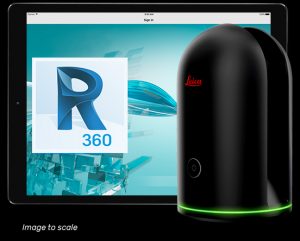 Using the ReCap Pro 360 mobile app, the BLK360 streams image and point cloud data to iPad. The app filters and registers scan data in real-time. After capture, ReCap 360 Pro enables for point cloud data transfer to a number of CAD, BIM, VR and AR applications. The integration of BLK360 and Autodesk software will dramatically streamline the reality capture process thereby opening this technology to non-surveying individuals.
Using the ReCap Pro 360 mobile app, the BLK360 streams image and point cloud data to iPad. The app filters and registers scan data in real-time. After capture, ReCap 360 Pro enables for point cloud data transfer to a number of CAD, BIM, VR and AR applications. The integration of BLK360 and Autodesk software will dramatically streamline the reality capture process thereby opening this technology to non-surveying individuals.
“When Autodesk first introduced ReCap, it was for one purpose: the democratization of reality capture,” said Aaron Morris, who oversees reality solutions at Autodesk. “We saw the tremendous power of this technology for the AEC industry, but realized that the cost and portability of scanners combined with difficult-to-use data was limiting the adoption of reality capture. Autodesk’s collaboration with Leica Geosystems helps solve these issues by giving just about anyone access to the amazing advantages of reality data.”
“As the leader in the spatial measurement arena, we recognized the gap between Leica Geosystems’ scientific-grade 3D laser scanners and emerging camera and handheld technologies, and set out to bring reality capture to everyone,” said Dr. Burkhard Boeckem, CTO of Hexagon Geosystems. “By combining and miniaturizing technologies available within Hexagon, the BLK360 defines a new category: the Imaging Laser Scanner. It is significantly smaller and lighter (1 kg) than any comparable device on the market. As we developed the ultimate sensor, we worked with Autodesk to create new software and ultimately achieved the next milestone in 3D reality capture. Together with Autodesk’s ReCap 360 Pro, the Leica BLK360 empowers every AEC professional to realize the benefits gained by incorporating high resolution 360° imagery and 3D laser scan data in their daily work.”
BLK360 & Autodesk ReCap 360 Pro Bundle will be available to order in March 2017. The anticipated bundle suggested retail price is $15,990/€15,000, which includes: BLK360 Scanner, Case, Battery, Charger and an annual subscription to ReCap 360 Pro. For customers who want to secure their spot in line to receive the first batch of BLK360 laser scanners, Autodesk and Leica Geosystems are offering a special limited promotion for a discounted three-year ReCap 360 Pro subscription with a voucher giving priority access to buy the BLK360. Go to this link to learn more.
Leica Geosystems – when it has to be right
Revolutionizing the world of measurement and survey for nearly 200 years, Leica Geosystems creates complete solutions for professionals across the planet. Known for premium products and innovative solution development, professionals in a diverse mix of industries, such as aerospace and defense, safety and security, construction, and manufacturing, trust Leica Geosystems for all their geospatial needs. With precise and accurate instruments, sophisticated software, and trusted services, Leica Geosystems delivers value every day to those shaping the future of our world.
Leica Geosystems is part of Hexagon (Nasdaq Stockholm: HEXA B; hexagon.com), a leading global provider of information technologies that drive quality and productivity improvements across geospatial and industrial enterprise applications.
Autodesk, the Autodesk logo, Autodesk ReCap 360, and Autodesk ReCap 360 Pro are registered trademarks or trademarks of Autodesk, Inc., and/or its subsidiaries and/or affiliates in the USA and/or other countries. All other brand names, product names or trademarks belong to their respective holders. Autodesk reserves the right to alter product and services offerings, and specifications and pricing at any time without notice, and is not responsible for typographical or graphical errors that may appear in this document.
Zoic Amps Up Neighborly Antics for ‘Keeping Up with The Joneses’
/0 Comments/in 3D Laser Scanning, LiDAR, Point Cloud, Visual Effects (VFX)/by Travis ReinkeLed by VFX supervisor Everett Burrell, Zoic Studios delivers big Hollywood explosions and high impact antics to amplify the humor of the film’s chance encounters and secret missions.
VANCOUVER, B.C. — Zoic Studios blasts mellow neighborhood envy to espionage proportions in the new action-adventure comedy Keeping Up with the Joneses from 20th Century Fox. The film follows an ordinary suburban couple (Zach Galifianakis, Isla Fisher) who finds it’s not easy keeping up with the Joneses (Jon Hamm, Gal Gadot), their impossibly gorgeous and ultra-sophisticated neighbors — especially when they discover that Mr. and Mrs. “Jones” are covert operatives. The Zoic team, led by VFX Supervisor Everett Burrell, delivered big Hollywood explosions and high impact antics to amplify the humor of the film’s chance encounters and secret missions. The film was released in theaters nationwide on October 21, 2016.Burrell worked closely with Special Effects Supervisor Michael Lantieri while on set in Atlanta, GA, to properly sync all practical effects for the augmentation executed in post-production. One heavy-hitting scene called for a fiery demolition of the Joneses’ house. The Zoic team collaborated with director Greg Mottola (Superbad, Paul) to bring his vision of an ‘80s movie-style detonation to reality. They intensified the larger-than-life eruption to leave audiences with no question of complete destruction, all while maintaining a photo-real look. Since an actual location was being utilized in lieu of a soundstage, none of the mansion blaze was captured practically, requiring the entire sequence to be created in CG.
Another scene called for Fisher and Galifianakis to spark a living room fire in a fantasy setting during a romantic moment gone wrong. The living room set was built twice, enabling the crew to practically ignite certain set elements and have Zoic Studios composite the flaming pieces into the scene in post-production.
While some practical stunt work called for VFX to bolster the action, certain moments required more comedy chops, including a scene where Galifianakis attempts a Hollywood-style jump through a glass window, only to bounce off the glass upon contact. To practically capture the moment, a stunt actor handled the brunt of the impact with Galifianakis jumping through an empty window placed in a hallway. The Zoic team seamlessly transitioned between the two performances to create a laughter-inducing moment for all.
Another sequence entailed creating the look of a 24-story vantage point from what was actually a 5-story perspective at a hotel. To implement this, the team placed a green screen on the floors between the pool, adding scale to the shots in CG to make the pool look significantly lower to the ground. Additional effects work included cleaning up shots to accelerate the action scenes, from practical stunts like removing rigs to muzzle flashes and bullet hits. The team also crafted a CG snake for a comical reptilian dining sequence between Hamm and Galifianakis.
“It was great working with director Greg Mottola to take the comedy to the next level. He has such extensive expertise in the genre and it was enjoyable to collaborate on the effects that would remain real and plausible in this comedy universe,” notes Burrell. “The comedy is so dialogue-driven, so we really worked to keep the VFX subtle and let the writing and performances speak for themselves.”
Velodyne LiDAR Announces Puck Hi-Res™ LiDAR Sensor
/0 Comments/in LiDAR, Mobile Scanning, New Hardware, New Technology/by Travis ReinkeVelodyne LiDAR Announces Puck Hi-Res™ LiDAR Sensor, Offering Higher Resolution to Identify Objects at Greater Distances
Industry-leading, real-time LiDAR sensor impacts autonomous vehicle, 3D mapping and surveillance industries with significantly higher resolution of 3D images
MORGAN HILL, Calif.–(BUSINESS WIRE)–Velodyne LiDAR Inc., the recognized global leader in Light, Detection and Ranging (LiDAR) technology, today unveiled its new Puck Hi-Res™ sensor, a version of the company’s groundbreaking LiDAR Puck that provides higher resolution in captured 3D images, which allows objects to be identified at greater distances. Puck Hi-Res is the third new LiDAR sensor released by the company this year, joining the standard VLP-16 Puck™ and the Puck LITE™.
“Not only does the Puck Hi-Res provide greater detail in longer ranges, but it retains all the functions of the original VLP-16 Puck that shook up these industries when it was introduced in September 2014.”
“Introducing a high-resolution LiDAR solution is essential to advancing any industry that leverages the capture of 3D images, from autonomous navigation to mapping to surveillance,” said Mike Jellen, President and COO, Velodyne LiDAR. “The Puck Hi-Res sensor will provide the most detailed 3D views possible from LiDAR, enabling widespread adoption of this technology while increasing safety and reliability.”
Expanding on Velodyne LiDAR’s groundbreaking VLP-16 Puck, a 16-channel, real-time 3D LiDAR sensor that weighs just 830 grams, Puck Hi-Res is used in applications that require greater resolution in the captured 3D image. Puck Hi-Res retains the VLP-16 Puck’s 360° horizontal field-of-view (FoV) and 100-meter range, but delivers a 20° vertical FoV for a tighter channel distribution – 1.33° between channels instead of 2.00° – to deliver greater details in the 3D image at longer ranges. This will enable the host system to not only detect, but also better discern, objects at these greater distances.
“Building on the VLP-16 Puck and the Puck LITE, the Puck Hi-Res was an intuitive next step for us, as the evolution of the various industries that rely on LiDAR showed the need for higher resolution 3D imaging,” said Wayne Seto, product line manager, Velodyne LiDAR. “Not only does the Puck Hi-Res provide greater detail in longer ranges, but it retains all the functions of the original VLP-16 Puck that shook up these industries when it was introduced in September 2014.”
“The 3D imaging market is expected to grow from $5.71B in 2015 to $15.15B in 2020, led by the development of autonomous shuttles for large campuses, airports, and basically anywhere there’s a need to safely move people and cargo,” said Dr. Rajender Thusu, Industry Principal for Sensors & Instruments, Frost & Sullivan. “We expect Velodyne LiDAR’s line of sensors to play a key role in this surge in autonomous vehicle development, as the company leads the way in partnerships with key industry drivers, along with the fact that sensors like the new Puck Hi-Res are substantially more sophisticated than competitive offerings and increasingly accessible to all industry players.”
Velodyne LiDAR is now accepting orders for Puck Hi-Res, with a lead-time of approximately eight weeks.
About Velodyne LiDAR
Founded in 1983 by David S. Hall, Velodyne Acoustics Inc. first disrupted the premium audio market through Hall’s patented invention of virtually distortion-less, servo-driven subwoofers. Hall subsequently leveraged his knowledge of robotics and 3D visualization systems to invent ground breaking sensor technology for self-driving cars and 3D mapping, introducing the HDL-64 Solid-State Hybrid LiDAR sensor in 2005. Since then, Velodyne LiDAR has emerged as the leading supplier of solid-state hybrid LiDAR sensor technology used in a variety of commercial applications including advanced automotive safety systems, autonomous driving, 3D mobile mapping, 3D aerial mapping and security. The compact, lightweight HDL-32E sensor is available for applications including UAVs, while the VLP-16 LiDAR Puck is a 16-channel LiDAR sensor that is both substantially smaller and dramatically less expensive than previous generation sensors. To read more about the technology, including white papers, visit http://www.velodynelidar.com.
Contacts
Velodyne LiDAR
Laurel Nissen
lnissen@velodyne.com
or
Porter Novelli/Voce
Andrew Hussey
Andrew.hussey@porternovelli.com
Hennessy Launches “Harmony. Mastered from Chaos.” Interactive Campaign using LiDAR Scans
/0 Comments/in 3D Laser Scanning, Animation, LiDAR, Point Cloud, Visual Effects (VFX)/by Travis ReinkeNEW YORK, June 30, 2016 /PRNewswire/ — Hennessy, the world’s #1 Cognac, today announced “Harmony. Mastered from Chaos.” –a dynamic new campaign that brings to life the multitude of complex variables that are artfully and expertly mastered by human touch to create the brand’s most harmonious blend, V.S.O.P Privilège. Set to launch June 30th, the campaign showcases the absolute mastery exuded at every stage of crafting this blend. This first campaign in over ten years also offers a glimpse into the inner workings of Hennessy’s mysterious Comité de Dégustation (Tasting Committee)—perhaps the ideal example of Hennessy’s mastery—that crafts the same rich, high quality liquid year over year. Narrated by Leslie Odom, Jr., the campaign features 60, 30 and 15 second digital spots and an interactive digital experience, adding another vivid chapter to the brand’s “Never stop. Never settle.” platform.
“Sharing the intriguing story of the Hennessy Tasting Committee, its exacting practices and long standing rituals, illustrates the crucial role that over 250 years of tradition and excellence play in mastering this well-structured spirit,” said Giles Woodyer, Senior Vice President, Hennessy US. “With more and more people discovering Cognac and seeking out the heritage behind brands, we knew it was the right time to launch the first significant marketing campaign for V.S.O.P Privilège.”

The “Harmony. Mastered from Chaos.” campaign showcases the numerous, complex variables that are mastered in order to create the harmony and balance of Hennessy V.S.O.P Privilège.
The “Harmony. Mastered from Chaos.” campaign showcases the numerous, complex variables that are mastered in order to create the harmony and balance of Hennessy V.S.O.P Privilège.

Hennessy’s Comité de Dégustation is a group of seven masters, including seventh generation Master Blender, Yann Fillioux, unparalleled in the world of Cognac. These architects of time oversee the eaux-de-vie to ensure that every bottle of V.S.O.P Privilège is perfectly balanced despite the many intricate variables present during creation of the Cognac. From daily tastings at exactly 11am in the Grand Bureau (whose doors never open to the public) to annual tastings of the entire library of Hennessy eaux-de-vie (one of the largest and oldest in the world), this august body meticulously safeguards the future of Hennessy, its continuity and legacy.
Through a perfectly orchestrated phalanx marked by an abundance of tradition, caring and human touch, V.S.O.P Privilège is created as a complete and harmonious blend: the definitive expression of a perfectly balanced Cognac. Based on a selection of firmly structured eaux-de-vie, aged largely in partially used barrels in order to take on subtle levels of oak tannins, this highly characterful Cognac reveals balanced aromas of fresh vanilla, cinnamon and toasty notes, all coming together with a seamless perfection.
“Harmony. Mastered from Chaos.”
In partnership with Droga5, the film and interactive experience were directed by Ben Tricklebank of Tool of North America, and Active Theory, a Los Angeles-based interactive studio. From the vineyards in Cognac, France, to the distillery and Cognac cellars, viewers are taken on a powerful and modern cinematic journey to experience the scrupulous process of crafting Hennessy VSOP Privilège. The multidimensional campaign uses a combination of live-action footage and technology, including 3D lidar scanning, depth capture provided by SCANable, and binaural recording to visualize the juxtaposition of complexity versus mastery that is critical to the Hennessy V.S.O.P Privilège Cognac-making process.
“Harmony. Mastered from Chaos.” will be supported by a fully integrated marketing campaign including consumer events, retail tastings, social and PR initiatives. Consumers will be able to further engage with the brand through the first annual “Cognac Classics Week” hosted by Liquor.com, taking place July 11-18 to demonstrate the harmony that V.S.O.P Privilège adds to classic cocktails. Kicking off on Bastille Day in a nod to Hennessy’s French heritage, mixologists across New York City, Chicago, and Los Angeles will offer new twists on classics such as the French 75, Sidecar, and Sazerac, all crafted with the perfectly balanced V.S.O.P Privilège.
For more information on Cognac Classics Week, including a list of participating bars and upcoming events, visitwww.Liquor.com/TBD and follow the hashtag #CognacClassicsWeek.
To learn more about “Harmony. Mastered from Chaos.” visit Hennessy.com or Facebook.com/Hennessy.
ABOUT HENNESSY
In 2015, the Maison Hennessy celebrated 250 years of an exceptional adventure that has lasted for seven generations and spanned five continents.
It began in the French region of Cognac, the seat from which the Maison has constantly passed down the best the land has to give, from one generation to the next. In particular, such longevity is thanks to those people, past and present, who have ensured Hennessy’s success both locally and around the world. Hennessy’s success and longevity are also the result of the values the Maison has upheld since its creation: unique savoir-faire, a constant quest for innovation, and an unwavering commitment to Creation, Excellence, Legacy, and Sustainable Development. Today, these qualities are the hallmark of a House – a crown jewel in the LVMH Group – that crafts the most iconic, prestigious Cognacs in the world.
Hennessy is imported and distributed in the U.S. by Moët Hennessy USA. Hennessy distills, ages and blends spanning a full range: Hennessy V.S, Hennessy Black, V.S.O.P Privilège, X.O, Paradis, Paradis Impérial and Richard Hennessy. For more information and where to purchase/ engrave, please visit Hennessy.com.
Video – https://youtu.be/vp5e8YV0pjc
Photo – http://photos.prnewswire.com/prnh/20160629/385105
Photo – http://photos.prnewswire.com/prnh/20160629/385106
SOURCE Hennessy
Leica Pegasus Backpack Wearable Reality Capture – Indoors, Outdoors, Anywhere
/0 Comments/in 3D Laser Scanning, LiDAR, Mobile Scanning, News, Point Cloud/by Travis ReinkeUltra mobile reality capture sensor platform – authoritative professional documentation indoors or outdoors
Leica Pegasus Backpack is a unique wearable reality capturing sensor platform combining cameras and Lidar profilers with the lightness of a carbon fiber chassis and a highly ergonomic design. The Pegasus:Backpack enables extensive and efficient indoor or outdoor documentation at a level of accuracy that is authoritative and professional. The Pegasus:Backpack is designed for rapid and regular reality capture – no longer is scanning registration needed for progressive scanning. The Pegasus:Backpack is just completely portable – enabling it to be checked in as luggage on a flight – simply fly-in, wear, collect, then fly-out. As part of the Pegasus platform, the Pegasus:Backpack is designed to act as a sensor platform with our standard external trigger and sync port outputs.
Leica Pegasus:Backpack
Map indoors, outdoors, underground, anywhere
Making progressive professional BIM documentation a reality with the Leica Pegasus:Backpack solution, synchronising imagery and point cloud data together, therefore assuring a complete documentation of a building for full life cycle management. By using SLAM (Simultaneous Localization and Mapping) technology and a high precision IMU, we ensure accurate positioning with GNSS outages – ensuring the best known position independent of how it is used.
With the Leica Pegasus:Backpack outdoor areas or underground infrastructures with limited access professional data collection is no longer limited . By capturing full 360 spherical view and Lidar together means you never forget an object or return to a project site – no matter where you are. A hardware light sensor ensures the operator that all images are usable while other functions are verifiable and adjustable over the operators tablet device.
Main features
- Indoor and outdoor mapping in one single solution – position agnostic
- Marries imagery and point cloud data into a single calibrated, user-intuitive platform
- Full calibrated spherical view
- External trigger output and external time stamping for additional sensors
- Light sensor for auto brightness and balance control for image capture
- Software enables access to Esri® ArcGIS for Desktop
- Capture and edit 3D spatial objects from images and / or within the point cloud
- Economical with data – balances data quantity and quality, with project logistics and post-processing
- Ultra light weight carbon fiber core frame with an extensive ergonomic support for prolonged use
- Real time view of the captured data through the tablet device
- Up to 6 hours operational time with optional battery pack
Hardware features
- Two profilers with 600,000 pts/sec, 50 m usable range and 16 channels
- Largest sensor to pixel in the market – 5.5 um x 5.5 um
- Five 4 MB cameras positioned to capture 360° x 200° view
- User adjustable acquisition intervals based on the distance travelled
- NovAtel ProPak6™ provides the latest and most sophisticated precise GNSS receiver with a robust field proven IMU for position accuracy of 20 mm RMS after 10 seconds of outage
- Marrying a triple band GNSS system with the latest multiple beam enabled SLAM algorithms
- INS determination of the location, speed, velocity and orientation at a rate of 200 Hz
- Ultra portable system fitting into one carrying case (system weight 13 kg)
- Battery based – using four batteries in a hot swappable configuration
- Multi-core industrial PC, 1 TB SSD, USB3 interface, ethernet, and wireless connection from the system to the tablet device

Leica Pegasus:Backpack enables unimaginable applications for indoor and outdoor mapping combining visual images with the accuracy of a point cloud for professional documentation – in a wearable, ergonomic, and ultra light carbon fiber construction.
Software features
- User capable of adding acquisition point objects in a Shapefile format during data acquisition
- Advanced export capability for CAD-systems and others (DWG, DXF, SHP, GDB, DGN, E57, HPC, LAS, PTS, NMEA, KMZ)
- Semi-automatic extraction tools
- Sequenced images and videos for rapid navigation and object recognition
- Software pointer “snaps” automatically and continuously onto the point cloud data from within an image
- Immediate access to point clouds for accurate measurement
- 3D stereoscopic view to decrease errors and increase throughput
- Shadowed or missing 3D points can be acquired via photogrammetric processes
- Data capture module displays the current location based on a GIS user interface
- Data capture module displays all cameras and Lidar scans live, simultaneously
- Data capture module enables laser scanner management and GNSS Operation
- Live status monitoring of system during data acquisition
Software benefits
- Lidar accuracy with image-based usability
- Digitise spatial objects through mobile mapping
- A more natural approach for non-professional users while offering technical interface for advanced users
- Scalable to your applications including less accurate simple GIS needs
- Short data acquisition time
- High acquisition throughput
- High post-processing throughput
- Manageable license options – compatible with thin-client viewer
- Esri® ArcGIS for Desktop compatible
- Leverages Esri® relational platform for advanced features
Andersson Technologies releases SynthEyes 1502 3D Tracking Software
/0 Comments/in 3D Laser Scanning, Animation, LiDAR, Point Cloud, Software, Visual Effects (VFX)/by Travis ReinkeAndersson Technologies has released SynthEyes 1502, the latest version of its 3D tracking software, improving compatibility with Blackmagic Design’s Fusion compositing software.
Reflecting the renewed interest in Fusion
According to the official announcement: “Blackmagic Design’s recent decision to make Fusion 7 free of charge has led to increased interest in that package. While SynthEyes has exported to Fusion for many years now — for projects such as Battlestar Galactica — Andersson Technologies LLC upgraded SynthEyes’s Fusion export.”
Accordingly, the legacy Fusion exporter now supports 3D planar trackers; primitive, imported, or tracker-built meshes; imported or extracted textures; multiple cameras; and lens distortion via image maps.
The new lens distortion feature should make it possible to reproduce the distortion patterns of any real-world lens without its properties having been coded explicitly in the software or a custom plugin.
A new second exporter creates corner pin nodes in Fusion from 2D or 3D planar trackers in SynthEyes.
Other new features in SynthEyes 1502 include an error curve mini-view, a DNG/CinemaDNG file reader, and a refresh of the user interface, including the option to turn toolbar icons on or off.
Pricing and availability
SynthEyes 1502 is available now for Windows, Linux and Mac OS X. New licences cost from $249 to $999, depending on which edition you buy. The new version is free to registered users.
New features in SynthEyes 1502 include:
- Toolbar icons are back! Some love ’em, some hate ’em. Have it your way: set the preference. Shows both text and icon by default to make it easiest, especially for new users with older tutorials. Some new and improved icons.
- Refresh of user interface color preferences to a somewhat darker and trendier look. Other minor appearance tweaks.
- New error curve mini-view.
- Updated Fusion 3D exporter now exports all cameras, 3D planars, all meshes (including imported), lens distortion via image maps, etc.
- New Fusion 2D corner pinning exporter.
- Lens distortion export via color maps, currently for Fusion (Nuke for testing).
- During offset tracking, a tracker can be (repeatedly) shift-dragged to different reference patterns on any frame, and SynthEyes will automatically adjust the offset channel keying.
- Rotopanel’s Import tracker to CP (control point) now asks whether you want to import the relative motion or absolute position.
- DNG/CinemaDNG reading. Marginal utility: DNG requires much proprietary postprocessing to get usable images, despite new luma and chroma blur settings in the image preprocessor.
- New script to “Reparent meshes to active host” (without moving them)
- New section in the user manual on “Realistic Compositing for 3-D”
- New tutorials on offset tracking and Fusion.
- Upgraded to RED 5.3 SDK (includes REDcolor4, DRAGONcolor2).
- Faster camera and perspective drawing with large meshes and lidar scan data.
- Windows: Installing license data no longer requires “right click/Start as Administrator”—the UAC dialog will appear instead.
- Windows: Automatically keeps the last 3 crash dumps. Even one crash is one too many.
- Windows: Installers, SynthEyes, and Synthia are now code-signed for “Andersson Technologies LLC” instead of showing “Unknown publisher”.
- Mac OS X: Yosemite required that we change to the latest XCode 6—this eliminated support for OS X 10.7. Apple made 10.8 more difficult as well.
About SynthEyes
SynthEyes is a program for 3-D camera-tracking, also known as match-moving. SynthEyes can look at the image sequence from your live-action shoot and determine how the real camera moved during the shoot, what the camera’s field of view (~focal length) was, and where various locations were in 3-D, so that you can create computer-generated imagery that exactly fits into the shot. SynthEyes is widely used in film, television, commercial, and music video post-production.
What can SynthEyes do for me? You can use SynthEyes to help insert animated creatures or vehicles; fix shaky shots; extend or fix a set; add virtual sets to green-screen shoots; replace signs or insert monitor images; produce 3D stereoscopic films; create architectural previews; reconstruct accidents; do product placements after the shoot; add 3D cybernetic implants, cosmetic effects, or injuries to actors; produce panoramic backdrops or clean plates; build textured 3-D meshes from images; add 3-D particle effects; or capture body motion to drive computer-generated characters. And those are just the more common uses; we’re sure you can think of more.
What are its features? Take a deep breath! SynthEyes offers 3-D tracking, set reconstruction, stabilization, and motion capture. It handles camera tracking, 2- and 3-D planar tracking, object tracking, object tracking from reference meshes, camera+object tracking, survey shots, multiple-shot tracking, tripod (nodal, 2.5-D) tracking, mixed tripod and translating shots, stereoscopic shots, nodal stereoscopic shots, zooming shots, lens distortion, light solving. It can handle shots of any resolution (Intro version limited to 1920×1080)—HD, film, IMAX, with 8-bit, 16-bit, or 32-bit float data, and can be used on shots with thousands of frames. A keyer simplifies and speeds tracking for green-screen shots. The image preprocessor helps remove grain, compression artifacts, off-centering, or varying lighting and improve low-contrast shots. Textures can be extracted for a mesh from the image sequence, producing higher resolution and lower noise than any individual image. A revolutionary Instructible Assistant, Synthia™, helps you work faster and better, from spoken or typed natural language directions.
SynthEyes offers complete control over the tracking process for challenging shots, including an efficient workflow for supervised trackers, combined automated/supervised tracking, offset tracking, incremental solving, rolling-shutter compensation, a hard and soft path locking system, distance constraints for low-perspective shots, and cross-camera constraints for stereo. A solver phase system lets you set up complex solving strategies with a visual node-based approach (not in Intro version). You can set up a coordinate system with tracker constraints, camera constraints, an automated ground-plane-finding tool, by aligning to a mesh, a line-based single-frame alignment system, manually, or with some cool phase techniques.
Eyes starting to glaze over at all the features? Don’t worry, there’s a big green AUTO button too. Download the free demo and see for yourself.
What can SynthEyes talk to? SynthEyes is a tracking app; you’ll use the other apps you already know to generate the pretty pictures. SynthEyes exports to about 25 different 2-D and 3-D programs. The Sizzle scripting language lets you customize the standard exports, or add your own imports, exports, or tools. You can customize toolbars, color scheme, keyboard mapping, and viewport configurations too. Advanced customers can use the SyPy Python API/SDK.
Latest Projects
 Fallout (Amazon Studios)September 21, 2023 - 9:58 pm
Fallout (Amazon Studios)September 21, 2023 - 9:58 pm Blue Beetle (DC Studios)July 18, 2023 - 8:04 pm
Blue Beetle (DC Studios)July 18, 2023 - 8:04 pm The Out-Laws (Netflix)June 6, 2023 - 5:04 pm
The Out-Laws (Netflix)June 6, 2023 - 5:04 pm Fast X (Universal Pictures)May 19, 2023 - 10:03 pm
Fast X (Universal Pictures)May 19, 2023 - 10:03 pm Crater (Disney+)May 12, 2023 - 8:00 am
Crater (Disney+)May 12, 2023 - 8:00 am
 MoPho Studios announced by the leading VFX 3D Scanning Studio...November 7, 2022 - 7:00 am
MoPho Studios announced by the leading VFX 3D Scanning Studio...November 7, 2022 - 7:00 am Pinewood Atlanta Studios, Home to ‘Avengers: Endgame,’...October 7, 2020 - 6:00 am
Pinewood Atlanta Studios, Home to ‘Avengers: Endgame,’...October 7, 2020 - 6:00 am Fire, Prosthetics, LED’s and VFX: ‘Project ...August 15, 2020 - 6:00 am
Fire, Prosthetics, LED’s and VFX: ‘Project ...August 15, 2020 - 6:00 am Packed stadiums, crowds, intimacy: Will VFX solve shooting...July 14, 2020 - 6:15 am
Packed stadiums, crowds, intimacy: Will VFX solve shooting...July 14, 2020 - 6:15 am
Locations
+1 (877) 899-2931
Office Locations:
Atlanta Office
Trilith Studios Media Park
500 Sandy Creek Road
WH2008 Suite 101
Fayetteville, GA 30214
New York Office
630 Flushing Avenue Suite 503
Brooklyn, NY 11206
Los Angeles Office
6080 Center Drive
Suite 600
Los Angeles, California 90045
Houston Office
2002 Timberloch Place
Suite 200
The Woodlands, Texas 77380
New Orleans Office
201 St Charles Ave #2500
New Orleans, LA 70170

